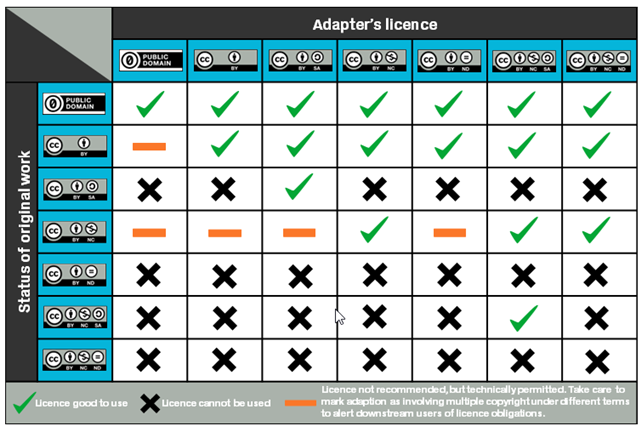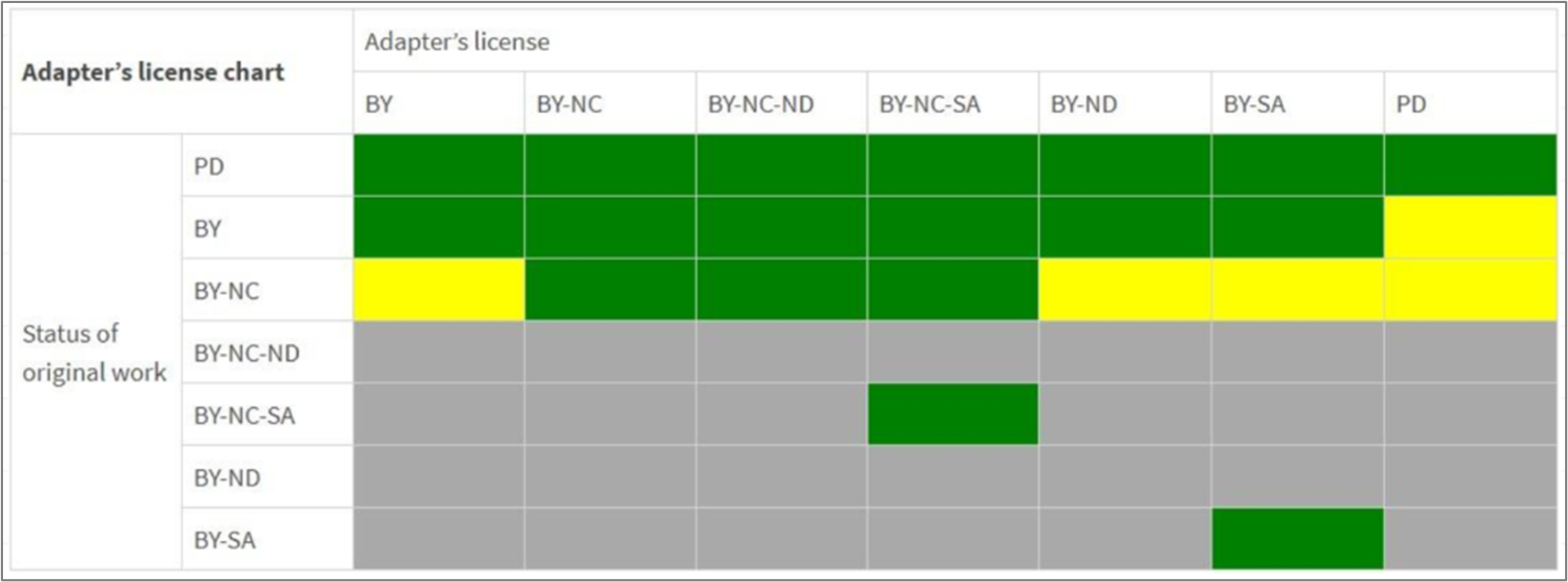7 Understanding Creative Commons Licence Compatibility
Before You Start Combining Licences
-
Download this free template, Record of Permissions (Excel download). It will help you keep track of third-party copyright content permissions.
-
Watch this video about Combining Creative Commons Licences for OERs [4:15]
Video: Combining Creative Commons Licences for OERs [4:52] by Florida Virtual Campus is licensed under Creative Commons Attribution-ShareAlike 3.0 Unported
“Creator” Versus “User” Licences
You need to understand the different types of CC licences, as both a potential user and creator of OER.
- As a potential OER user (adapter), you will review others’ OER for material to reuse. The terms of the licence will specify exactly how you may reuse the resource (Adapter’s licence).
- As a potential OER creator [of original content], you will need to think about what types of reuse, modification, translation and remix of your work you will permit before you select your CC licence (Original licence).
Table 7.1
Licensing Rules for Adapting Creative Commons Works
| Original Licence Applies to the Work | Required Licence for Your Adaptation |
| BY or BY-NC | Your adaptation must include the same licence elements as the original. For example, if you adapt a BY-NC work, you must apply BY-NC to your adaptation. If you adapt a BY work, you may apply BY or BY-NC. |
| BY-SA or BY-NC-SA | Your adaptation must use the same licence as the original, or a compatible one. |
| BY-ND or BY-NC-ND | You cannot distribute adaptations. |
Licence Compatibility
Licence compatibility is the term used to address the issue of which types of licensed works can be adapted into a new work.
-
Simple scenario: When creating an adaptation of a CC-licensed work, the simplest scenario is when you take a single CC-licensed work and adapt it.
-
More complicated scenario: The more complicated scenario is when you are adapting two or more CC-licensed works into a new work.
For either situation, think about your options for licensing the copyright you have in your adaptation (your Adapter’s Licence).
Note. Your rights in your adaptation only apply to your own contributions. The original licence continues to govern the reuse of the elements from the original work that you used when creating your adaptation.
Remixing Charts
Chart 1. How Licences Can Be Combined
Use this chart to determine whether two licences are compatible and whether they can be combined.
Figure 7.1
CC License Compatibility Chart

How to use the chart
Find a licence that applies to one of the works in the left column and the licence that applies to the other work in the top right row.
- If there is a check mark (“√“) in the box where that row and column intersect, the works under those two licences can be remixed.
- If there is an “X” in the box, the work may not be remixed unless an exception or limitation applies.
Chart 2. Variation on the CC Licence Compatibility Chart
The CC Adapter’s Licence Chart is a variation on the CC Licence Compatibility Chart. Use this chart to determine which licence to apply to your own work (Adapter’s Licence) by comparing it to the original work.
Figure 7.3
CC Adapter’s Licence Chart

Chart 3. Selecting an Adapter’s Licence
Chart 3 is an alternative version of Chart 2. Use this chart to determine which licence to apply to your own work (Adapter’s Licence) by comparing it to the original work.
Figure 7.2
Adapter’s Licence Chart


